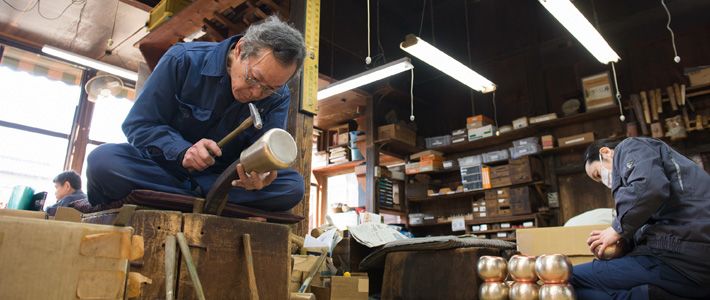
Tea and Sake Copperware by Gyokusendō: Combining Tradition and Innovation
Culture- English
- 日本語
- 简体字
- 繁體字
- Français
- Español
- العربية
- Русский
An Open Workshop to Enhance Value
“Please don’t describe our work in too much detail,” comes the greeting from Yamada Ritsu, general manager of Gyokusendō Tsubame, as we began our visit to the head office of the long-established copperware firm.
 Clockwise from top: The Gyokusendō head office building is a national registered tangible cultural property; store shelves lined with outstanding examples of the company’s products; Gyokusendō’s general manager, Yamada Ritsu.
Clockwise from top: The Gyokusendō head office building is a national registered tangible cultural property; store shelves lined with outstanding examples of the company’s products; Gyokusendō’s general manager, Yamada Ritsu.
“All Gyokusendō’s products are made by hand, and with just twenty-one artisans on our staff, we cannot produce them on a mass scale,” says Yamada. “Thanks to the high reputation we enjoy among our customers, we rarely advertise and do not intend to expand our sales channels. The reason we allow visits from the media is that we want to encourage many people come to our workshop and see just how much painstaking effort goes into making each of our products.”
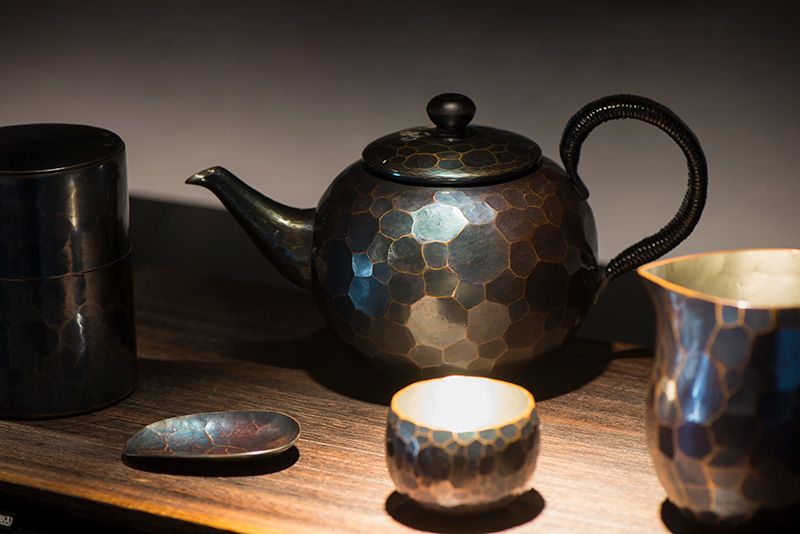 Gyokusendō’s beautiful and tasteful Tsuiki copperware.
Gyokusendō’s beautiful and tasteful Tsuiki copperware.
Gyokusendō allows people to tour its workshop at any time during working hours, without a reservation. The aim is to help people appreciate the value of Tsuiki copperware. The first stop on the tour is a look at the fabrication process, with artisans creating samples for the visitors. In this process, the edges of a single copper sheet are first raised with a wooden mallet. The worker then strikes the piece with a hammer, reducing its diameter and forming the final shape. This work takes an enormous amount of time and labor to build up a three-dimensional vessel.
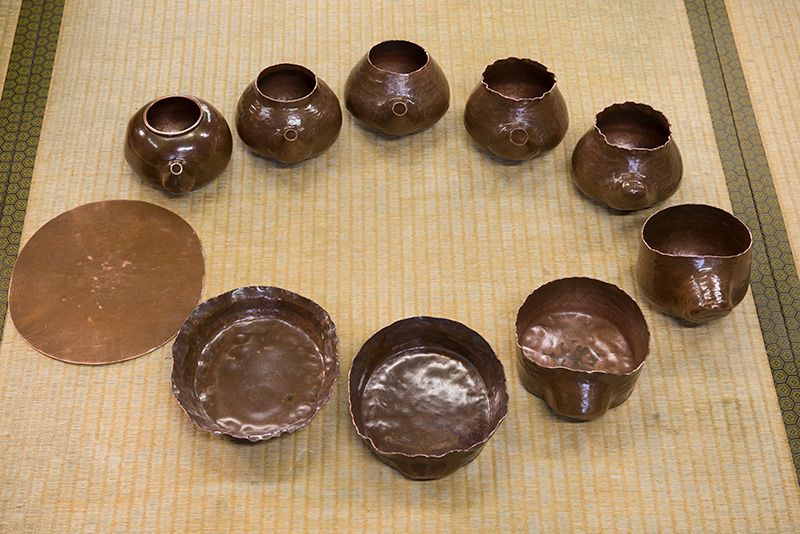 The fabrication process proceeds counterclockwise, starting with the copper plate on the left. Usually, several pieces are put through each labor-intensive process at the same time, but if a single piece were done from start to finish it would take more than two weeks to complete.
The fabrication process proceeds counterclockwise, starting with the copper plate on the left. Usually, several pieces are put through each labor-intensive process at the same time, but if a single piece were done from start to finish it would take more than two weeks to complete.
“Our tea kettles cost more than 50,000 yen, even for the less expensive ones whose pouring spouts are crafted separately and attached after the main vessels are shaped,” says Yamada. “The ones we call kuchi uchidashi, or ‘pounded-out spouts,’ with every part of the kettle made from a single sheet of copper, run around 500,000 yen. The difference is clear in the actual products, but more importantly, if you see the painstaking tasks we do in the workshop you’ll understand that this price is reasonable.
“If people who already own Tsuiki copperware sees this, they’ll treasure these pieces even more and treat them with great care. But if your readers feel like they’ve come to the workshop just by viewing your article, they won’t make the trip and get the real experience. That’s why I asked you not to write in too much detail!” laughs Yamada. “I urge everyone to come visit the actual workshop at least once.”
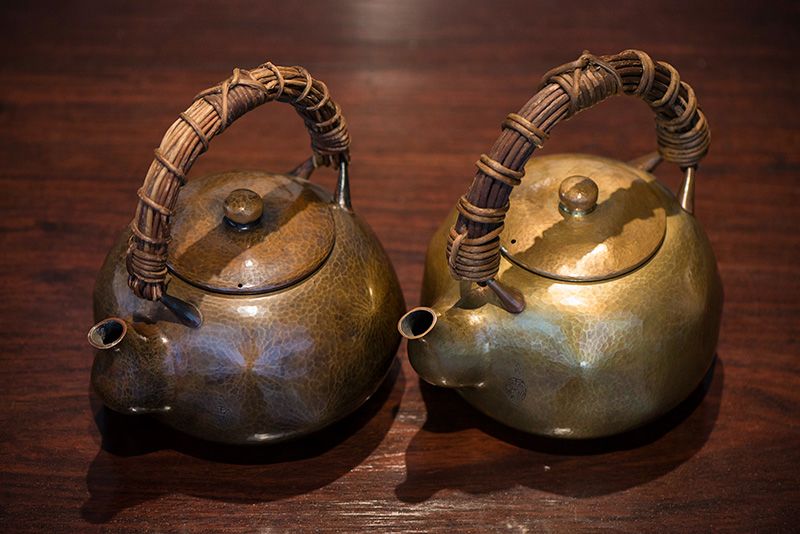 These two kuchi uchidashi teakettles are the same product, but the one on the right is new and the one on the left has been used for 50 years. “These kettles develop a deeper aesthetic quality with use over many years. People often ask us to sell them the one on the left, but we can hardly do that,” says Yamada.
These two kuchi uchidashi teakettles are the same product, but the one on the right is new and the one on the left has been used for 50 years. “These kettles develop a deeper aesthetic quality with use over many years. People often ask us to sell them the one on the left, but we can hardly do that,” says Yamada.
Original Techniques and Tools Developed Over Time
The sharp clanging sound of metal hammers rings throughout the workshop. The artisans wear earplugs, but even so, many of the older workers say it has become difficult for them to hear high-pitched sounds.
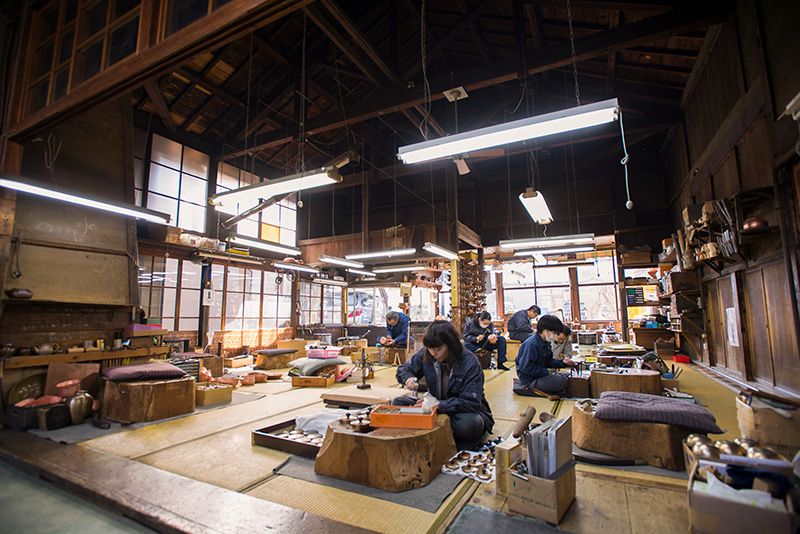 The high workshop ceiling weakens the echoes of the hammer noise, while large windows help to brighten the space.
The high workshop ceiling weakens the echoes of the hammer noise, while large windows help to brighten the space.
The implements that line the workshop’s walls and pillars are called toriguchi. These tools are Gyokusendō originals: artisans hand the copperware on them for working. The toriguchi are inserted into one of several holes made in a platform that looks like a tree stump, called an agariban. Artisans sit at these agariban to work on the copperware, with the toriguchi serving as an anvil for the hammer. Different ones are used depending on the process and the shape of the vessel, with 20–30 different types of toriguchi used to make a single product. The workshop is equipped with about 200 types of hammer and about 300 types of toriguchi.
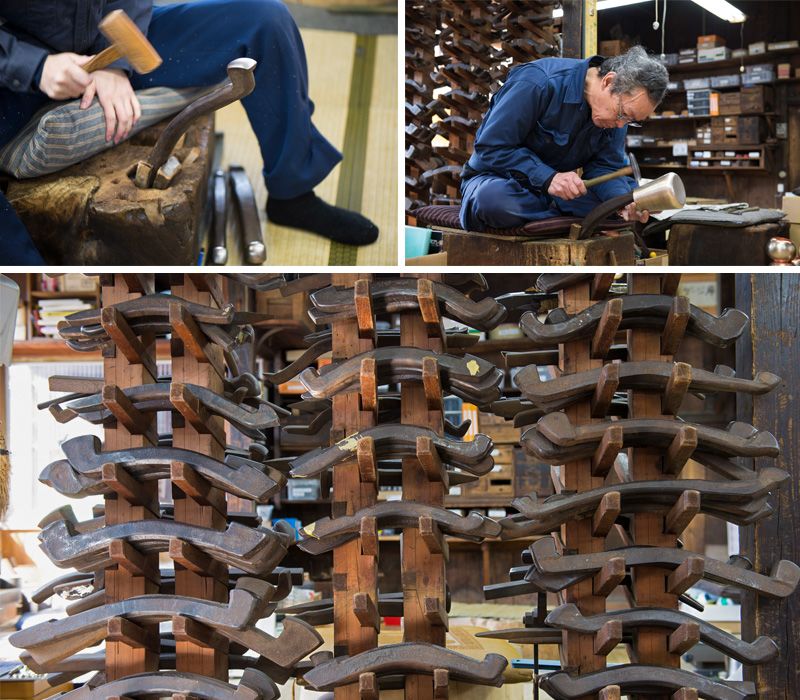 Clockwise from upper left: Toriguchi fixed in place in a block; using the block as a platform, the worker strikes the copper with metal hammers to form many different curved surfaces; large and small toriguchi of various shapes.
Clockwise from upper left: Toriguchi fixed in place in a block; using the block as a platform, the worker strikes the copper with metal hammers to form many different curved surfaces; large and small toriguchi of various shapes.
Once copper is put in the fire, it maintains its softness even after cooling. However, it rapidly becomes harder as its size is reduced by hammering. Pieces are repeatedly hammered, annealed in a furnace to restore their malleability, and hammered again to form beautiful copperware.
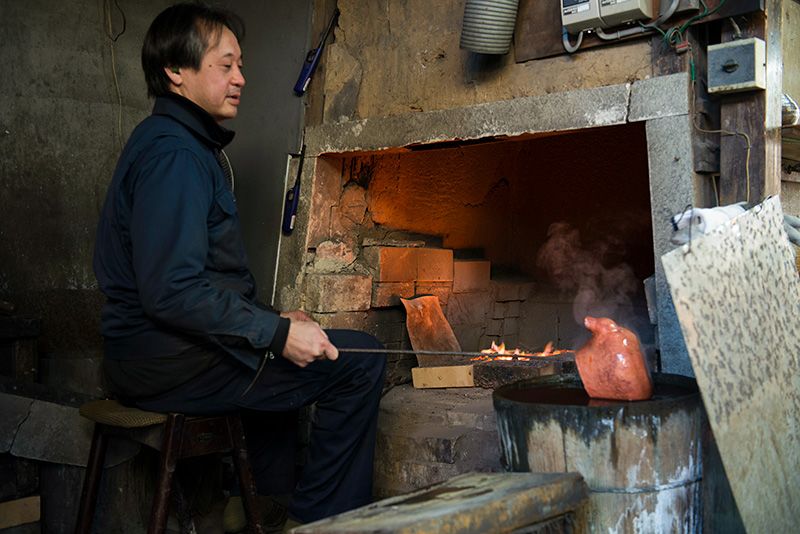 Chief master craftsman Tamagawa Tatsushi anneals a piece.
Chief master craftsman Tamagawa Tatsushi anneals a piece.
Gyokusendō products have abundant variations. The copperware has different surface types: Some feature a large hammered pattern called ōtsuchime, others have a textured pattern made with fine hammers, and there are also engraved items. The beautiful colors range from tones close to the original color of the copper to unique hues created by soaking the pieces in solutions potassium sulfide, plating them with tin, or using other original techniques.
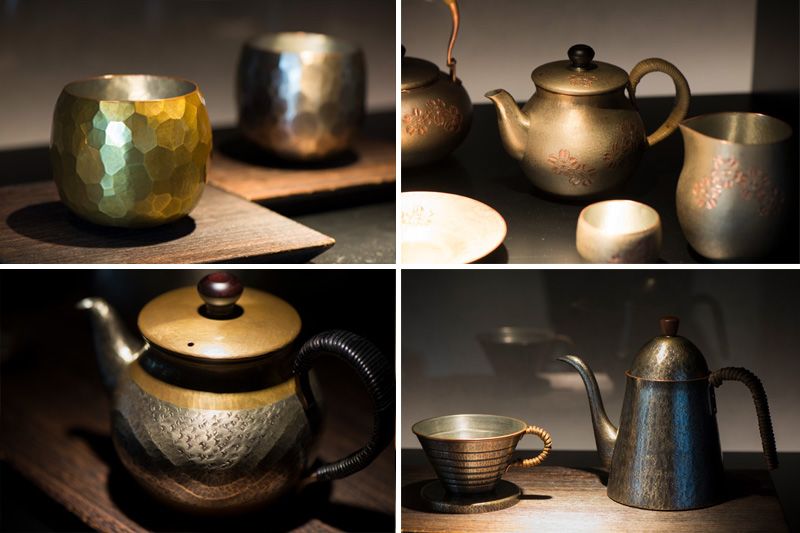 Clockwise from upper left: An ōtsuchime (large hammered pattern) sake cup; a teapot adorned with a flower pattern; an oxidized silver coffee pot; a teapot engraved with a streamline pattern.
Clockwise from upper left: An ōtsuchime (large hammered pattern) sake cup; a teapot adorned with a flower pattern; an oxidized silver coffee pot; a teapot engraved with a streamline pattern.
The techniques for Tsuiki copperware were introduced to what is now Niigata Prefecture by a craftsman traveling from Sendai in the late eighteenth century. Located near Tsubame were the Maze copper mine (located in today’s Nishiura in the city of Niigata) and Shitadago (Sanjō), a charcoal-producing district. The industry developed with the triad of technique, materials, and fuel. Today, the craft is carried on in Tsubame alone. Preserving the tradition is “exceedingly difficult,” says Chief Master Craftsman Tamagawa Tatsushi.
“When people hear ‘traditional crafts,’ they tend to think that we’re simply continuing to make things as they were made in the past. But it’s not that simple. For example, the Maze mine has closed. Now we use copper sheets imported from South America. Even if we wanted to make things in exactly the same way, the materials we used for many years may no longer be available and the tools we are familiar with may no longer be produced. We search the world for substitute materials and new tools. We’ve got to adjust our production techniques to them if we want to preserve the traditional craft.”
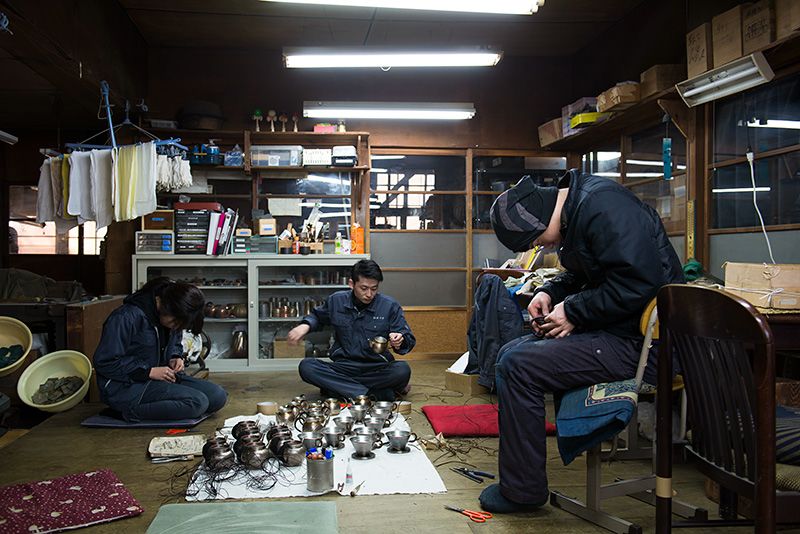 Artisans work with a type of string they have used for generations. When the specific string preferred by Gyokusendō recently became unavailable, the firm was forced to switch to material from a different production area.
Artisans work with a type of string they have used for generations. When the specific string preferred by Gyokusendō recently became unavailable, the firm was forced to switch to material from a different production area.
A Living National Treasure Attracts Attention
General Manager Yamada says that the image of traditional crafts as a rarified artistic pursuit is also mistaken. “Craft products are in the end nothing more than tools. They only have significance to people’s lives when they are actually being used at their tables.” He also echoes the words of company president Tamagawa Motoyuki, the seventh-generation head of the firm, who describes traditional crafts as “a continual process of innovation.’”
Gyokusendō started as Yakan’ya Kakubē, which made mainly kettles. The firm began exhibiting its wares at World Expositions starting with Vienna in 1873, and the second- and third-generation owners began using engraving and other decoration, adding artistic elements to their creations.
The biggest innovation in recent years was the incorporation of the wood-grained metal technique by Tamagawa Norio, Tatsushi’s father. More than 20 sheets of metal of different colors, such as copper, silver, and red copper, are overlaid and fused. The surface is then shaved with a chisel while being hammered, bringing out a richly colored, wood-grain-like pattern on the surface. Norio was certified as a Living National Treasure in 2010, the first Tsuiki copperware craftsman to be so honored.
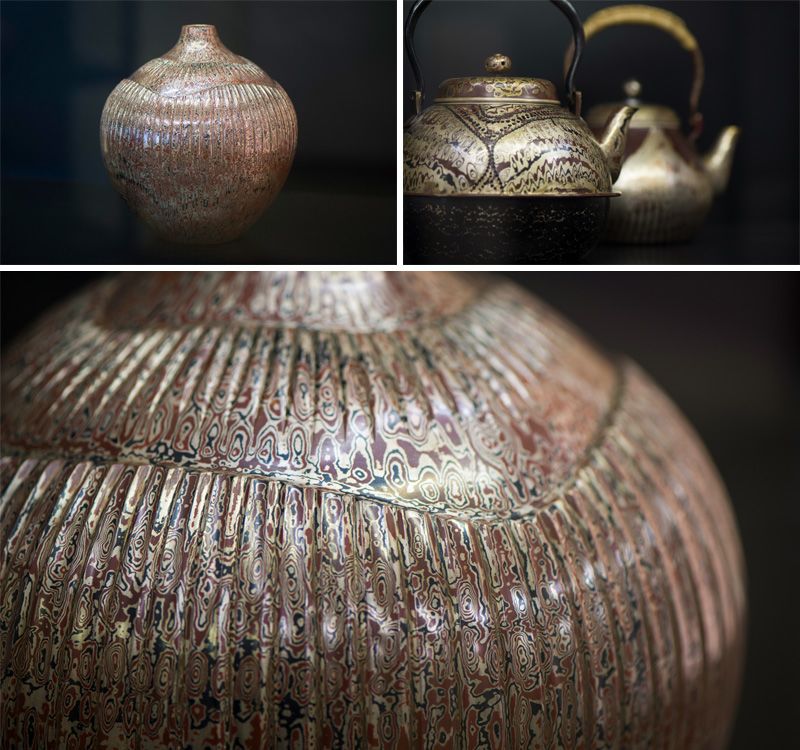 Clockwise from upper left: A wood-grained metal flower vase; a water kettle using the wood-grained technique; the metal layers flow intricately as they are formed by hammering silver and other metals, producing a deeply textured pattern.
Clockwise from upper left: A wood-grained metal flower vase; a water kettle using the wood-grained technique; the metal layers flow intricately as they are formed by hammering silver and other metals, producing a deeply textured pattern.
This designation as a Living National Treasure led to a rapid increase in the number of visitors to the workshop. When they first began counting five years ago, they were receiving 700 visitors a year. This had increased to 5,500 in 2016, with about 400 of these coming from other countries.
“Around the same time, our Tsubame Sanjō brand become widely known both in Japan and abroad, and I think that also had some effect. It was a happy turn of events,” says Yamada.
Even so, Gyokusendō continues to innovate, not satisfied with the status quo. Seven years ago the company hired the first female artisan to work there in its 200-year history; today that number has increased to six. Then, in April 2017, the company opened a shop in Ginza Six, a large upscale shopping complex in Tokyo that has attracted attention for its well-appointed facilities targeting tourists visiting Japan.
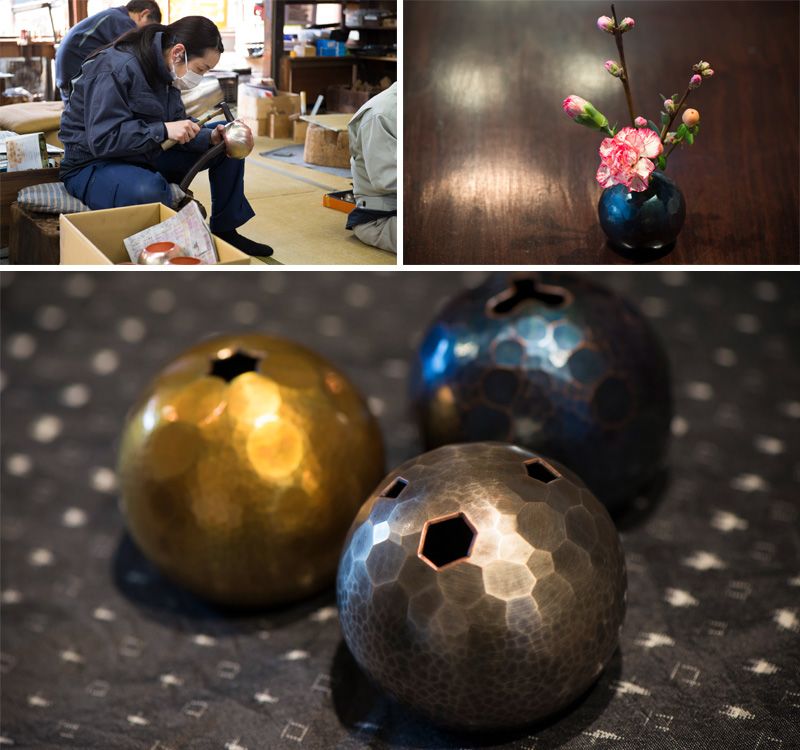 Clockwise from upper left: One of the company’s female artisans crafts a piece; a Gyokusendō vase; some of the vases intended for single flowers designed by female artisans.
Clockwise from upper left: One of the company’s female artisans crafts a piece; a Gyokusendō vase; some of the vases intended for single flowers designed by female artisans.
“From Ginza, we hope to show Tsuiki copperware and the Tsubame Sanjō brand to the world,” says Yamada. “The way we look at it, however, is that the Ginza shop is ultimately just a way to increase public awareness of Tsuiki copperware. Our main purpose is to attract people who become interested to our main store and workshop in Tsubame. We’d like visitors to hear the sound of the hammers, smell the solutions we use, and feel the heat of the fire. We hope they will then understand the feeling we put into these products as they purchase our Tsuiki copperware and use it with loving care.”
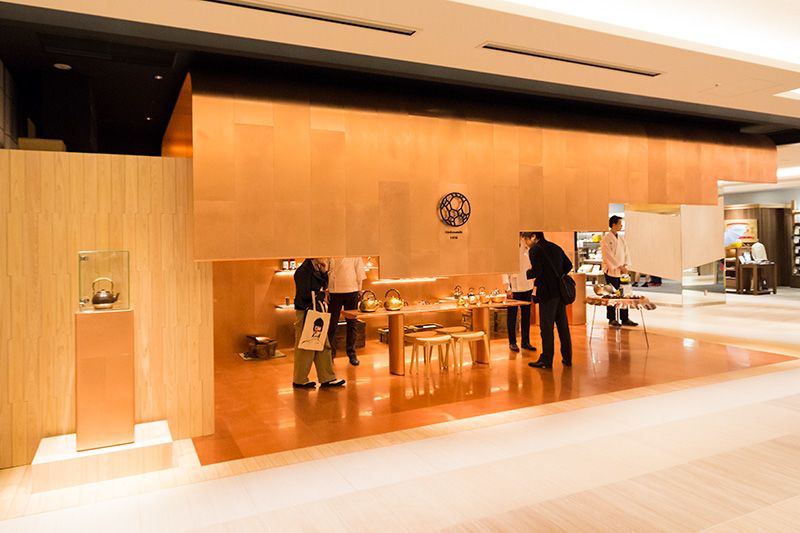 Gyokusendō Ginza, on the fourth floor of Ginza Six, is a gorgeous space decorated with hammered copper plates.
Gyokusendō Ginza, on the fourth floor of Ginza Six, is a gorgeous space decorated with hammered copper plates.
Store Information
Gyokusendō Main Store- Address: 2-2-21 Chuō-Dōri, Tsubame, Niigata 959-1244
- Opening hours: Weekdays 8:30 to 17:30
- Tel.: 0256-62-2015